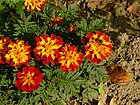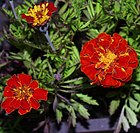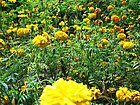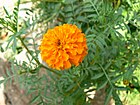Note: This is a project under development. The articles on this wiki are just being initiated and broadly incomplete. You can Help creating new pages.
Difference between revisions of "Tagetes erecta"
| Line 4: | Line 4: | ||
==Parts Used== | ==Parts Used== | ||
| − | {{Parts Used|Leaves}}, {{Parts Used|Flowers}. | + | {{Parts Used|Leaves}}, {{Parts Used|Flowers}}. |
==Chemical Composition== | ==Chemical Composition== | ||
Latest revision as of 16:40, 18 August 2020
African marigold is an aromatic, erect, annual plant that can grow up to 180cm tall, but is more likely to be around 25cm. The plant has a wide range of medicinal uses. It is also used as a flavouring in food, a popular dye plant and is an effective repellent. It is cultivated as a dye plant in the Americas, and is widely cultivated in temperate to tropical regions as an ornamental plant. This plant is belongs to Asteraceae family.
Contents
- 1 Uses
- 2 Parts Used
- 3 Chemical Composition
- 4 Common names
- 5 Properties
- 6 Habit
- 7 Identification
- 8 List of Ayurvedic medicine in which the herb is used
- 9 Where to get the saplings
- 10 Mode of Propagation
- 11 How to plant/cultivate
- 12 Commonly seen growing in areas
- 13 Photo Gallery
- 14 References
- 15 External Links
Uses
Indigestion, Colic, Severe constipation, Coughs, Dysentery, Sores, Ulcers, Eczema, Sore eyes, Rheumatism, Boils.[1]
Parts Used
Chemical Composition
Twenty five compounds were identified in the oil of T. erecta, of which linalool (22.5 %), 2-hexyl-l-decanol (18.3 %), piperitone (13.4 %), 4-terpinyl acetate (7.8 %) and caryophyllene (6.6 %) are the main components.[2]
Common names
| Language | Common name |
|---|---|
| Kannada | Chendu hu, Gondegida |
| Hindi | Genda |
| Malayalam | |
| Tamil | Turukkasamandi |
| Telugu | Banti |
| Marathi | |
| Gujarathi | |
| Punjabi | |
| Kashmiri | |
| Sanskrit | Janduga, Sthulapushpa |
| English | African merregold |
Properties
Reference: Dravya - Substance, Rasa - Taste, Guna - Qualities, Veerya - Potency, Vipaka - Post-digesion effect, Karma - Pharmacological activity, Prabhava - Therepeutics.
Dravya
Rasa
Guna
Veerya
Vipaka
Karma
Prabhava
Habit
Identification
Leaf
| Kind | Shape | Feature |
|---|---|---|
Flower
| Type | Size | Color and composition | Stamen | More information |
|---|---|---|---|---|
| {{{5}}} |
Fruit
| Type | Size | Mass | Appearance | Seeds | More information |
|---|---|---|---|---|---|
Other features
List of Ayurvedic medicine in which the herb is used
Where to get the saplings
Mode of Propagation
How to plant/cultivate
Requires a well-drained moderately fertile soil in a sunny position. Grows well in heavy clay soils and in sandy soils.[5]
Commonly seen growing in areas
Pine-oak forest zone, Dry thickets, On waste ground.
Photo Gallery
References
- ↑ Indian Medicinal Plants by C.P.Khare
- ↑ Chemical constituents
- ↑ Karnataka Aushadhiya Sasyagalu By Dr.Maagadi R Gurudeva, Page no:137
- ↑ [Morphology]
- ↑ Cultivation
External Links
- Ayurvedic Herbs known to be helpful to treat Indigestion
- Ayurvedic Herbs known to be helpful to treat Colic
- Ayurvedic Herbs known to be helpful to treat Severe constipation
- Ayurvedic Herbs known to be helpful to treat Coughs
- Ayurvedic Herbs known to be helpful to treat Dysentery
- Ayurvedic Herbs known to be helpful to treat Sores
- Ayurvedic Herbs known to be helpful to treat Ulcers
- Ayurvedic Herbs known to be helpful to treat Eczema
- Ayurvedic Herbs known to be helpful to treat Sore eyes
- Ayurvedic Herbs known to be helpful to treat Rheumatism
- Ayurvedic Herbs known to be helpful to treat Boils
- Herbs with Leaves used in medicine
- Herbs with Flowers used in medicine
- Herbs with common name in Kannada
- Herbs with common name in Hindi
- Herbs with common name in Tamil
- Herbs with common name in Telugu
- Herbs with common name in Sanskrit
- Herbs with common name in English
- Habit - Annual
- Index of Plants which can be propagated by Seeds
- Herbs that are commonly seen in the region of Pine-oak forest zone
- Herbs that are commonly seen in the region of Dry thickets
- Herbs that are commonly seen in the region of On waste ground
- Herbs





